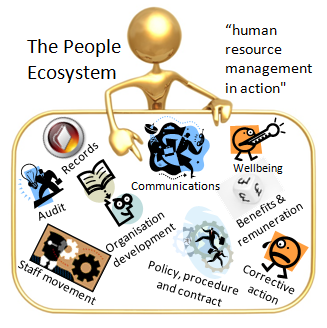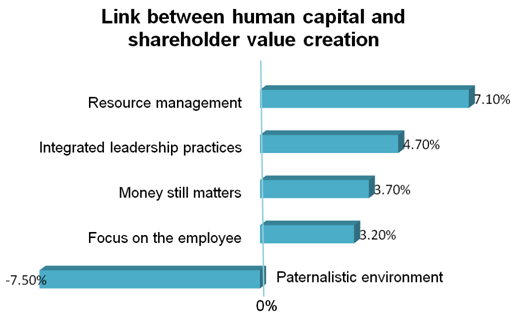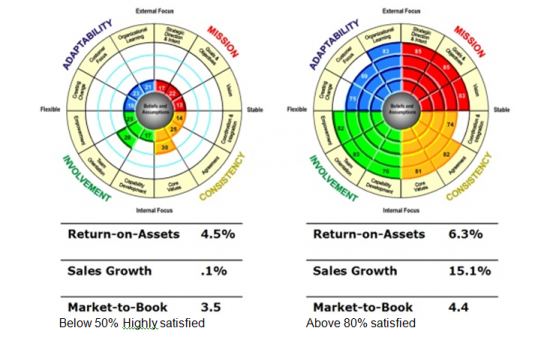One of several papers on general HR
Strategic HRM: People, Culture and the Bottom Line
Written by John Berry on 5th May 2017. Revised 13th November 2020.
11 min read
Introduction
Strategy is what guides firms in the long term. All firms have strategies and those who actively develop strategies are better for it than those who leave strategy to chance.
There is however no prescriptive methodology for developing a business strategy. Every strategy is unique to the firm providing a business framework for its future operations. Economists talk in terms of ‘short run’ and ‘long run’[1]. In the short run there is little that the principals of a firm can do to effect real change. In the long run, however, everything is variable.
Strategy means choice. It means improvement. It means change. Strategic HRM (Human Resource Management) is about changing people. It is about developing people. It is about putting in place a people ecosystem that optimises your business, facilitating an increase in your bottom line. It is about determining what needs to change, what needs to remain the same, and, it is about managing any resultant action to effect those changes identified so that they happen in the future, however distant that might be.
What is a People Ecosystem?
An ecosystem refers to the complex interactions and relationships between a community and its non-living environment. A people ecosystem is therefore the complex interaction between the employee and all the systems developed to manage the business.
Figure 1 below depicts these systems. The people ecosystem includes the terms and conditions of employment, the psychological contract (the apparent contract comprising expectations of both management and staff), the growth of knowledge in the firm, systems for reward and recognition and many others. Together they provide the building blocks for people management.
HR strategy is the setting up and management of these systems to optimise people contribution.
Conceptually, the more favourable the people ecosystem to the people, the more the people and the firm will flourish. A people ecosystem can be any size – supporting firms of one person to firms of thousands. But because humans have broadly the same needs and because humans respond similarly to stimulus, they all comprise similar parts. The differences come mostly from the nature of the firm and its aims and the nature of the people employed.
The ecosystem is concerned with the interactions and relationships between employees, managers and stakeholders and with the procedures and processes put in place to ensure the firms prosperity. The ecosystem needs to be designed to optimise that prosperity within the target firm. people ecosystem

When an ecosystem is balanced and in harmony it is said to be sustainable.
Sustainability is desirable. The alternative is a system in turmoil and that adds cost to the firm. It is therefore fundamental to all organisations that a sound HR strategy is developed to support the business objectives and create a sustainable ecosystem. This will facilitate the prosperity of the firm.
Where does your people ecosystem need to be?
Before HR strategy can be determined, the business strategy has to be identified.
Where do you want to be next year? And the next again?
Strategy involves having a vision of the future and it is often encapsulated in a ‘mission statement’. The business strategy describes a process by which an organisation develops and determines its future. It determines a logical framework which provides guidance for the organisation’s future development. It describes goals that the firm aims for and perhaps some end state. HR strategy is a part of that strategy and is one of the vehicles that ensure you to get there. In the ‘short run’ a firm can recruit unskilled staff and set them to work to support increased work load. It can lay off casual workers. It can’t however recruit and train skilled staff in the short-run. In the ‘long run’ a strategy can be put in place to recruit and train staff, developing skilled employees and grow managers into true business leaders.
In achieving future aims, it is the ‘long run’ that you should concern yourself with. By doing this the ‘short run’ will take care of itself.
Examples of strategic human resource management include the improvement of staff motivation through staff development; the increased involvement of staff in decision making through consultative committees; an increase in the service provided for customers through flexible working; achieving fewer product returns through knowledge management and knowledge workers and achieving increased morale by matching of people resources to business requirements.
Where is your people ecosystem today?
How do you find out?
The best way is to ask your staff, your customers and your suppliers. It is important that the feedback is asked for, and presented back, in a manner which is usable. Asking for the wrong feedback; or not developing your themes correctly will mean resultant data is not fit for purpose. There are many methods that can be employed to collect the data – 360 degree feedback from staff, questionnaires from customers and structured interviews to name but a few.
A focussed audit of the people ecosystem will provide a wealth of information. You may discover that your pay rates don’t allow you to recruit the right staff. Your staff may be keen to develop themselves, but can’t afford to fund their own training. You may realise that the constant stream of disciplinary and grievance meetings are getting in the way of progress. You may discover your sickness absence issues are impacting on more people than you realised. More importantly you may realise productivity is down. The result should be a good picture of where the people ecosystem currently is compared to where you want it.
How do you effect change?
The first thing you will need is external help. Not because you can’t effect change, but because you need impartiality and confidentiality. As a principal in the firm you have neither. You are going to need a framework against which to express where you want to move to and against which to make plans in order to make the move. There are many frameworks. The UK Government’s Investors in People (IiP) scheme provides one. The very action of going through IiP means that you have to think about your people ecosystem and your business strategy and to make sure the two align. Diagnostic tools provide another. These are designed to improve organisational culture and leadership such that you can achieve your chosen path.
Links with the bottom line
There is a huge amount of research which proves that managing the people ecosystem does impact hugely on the bottom line. Here we explore a small selection.
According to Chartered Institute of Personnel and Development[2] research there is a clear link between people management and business performance. CIPD notes that “the quality of people management is a better predictor of performance than business strategy, research and development or quality management.”[3] A further CIPD study which asked CEO’s to rate the effectiveness of HR practices in their firms showed “a link from effective HR practices to aspects of employee attitudes and behaviour ...and from this to organisational outcomes, such as higher comparative productivity, and, in turn, higher financial performance”[4]. This increase is real and tangible. Further proof comes from research conducted by Watson Wyatt, a major management consulting firm. Watson Wyatt conducted a pan- European survey in 2000[5] during which they developed the Human Capital Index (HCI) as a way of measuring the impact of HR practices on shareholder value. The research clearly showed that 19 key HR practices were associated with a 26% increase in result. The 19 factors were grouped into five dimensions. The impact of each is shown quantitatively in the diagram below.

The HCI study was conducted again in 2004, comparing original data for each organisation with the current situation. This showed even more staggering results.
Again the report concluded that positive HR practices have significant impact on the economic results of the organisation. Linking organisational culture and leadership development provides another powerful tool. Denison Consulting has developed such a model which providing a common framework linking both. In one case-study[6] they explain how an organisation was transformed from a ‘top-down’ management approach to a more balanced culture, integrating all staff. This strategic change achieved over three years meant that a low performing organisation (scoring less than 25% effectiveness in most scores) became much more focussed and efficient with scores between 70% and 85% in every index.

The results in Figure 3 are based research undertaken by Denison Consulting between 1996 and 2004.
They show that there is a significant improvement for firms with a strong culture – profitability, sales growth and market value are much higher when organisational culture and leadership are focused[7]. Culture and leadership are embodied within the people ecosystem. Further research by Denison shows that for research conducted on American public sector firms, return on equity (ROE) is significantly affected by the culture score. Average ROE for the organisations with the lowest culture scores is 6%; whereas those with the highest culture score the average ROE is 21%[8]. This is further evidence that getting the people ecosystem right has significant impact to a firm.
The final research discussed in this paper is Investors in People (IiP). This provides a framework designed to support an increase in performance by targeting business priorities identified by the firms themselves. Research undertaken by Cranfield University in 2008[9] concluded that firms adopting IiP “set up a chain of impact ending in better financial performance”[10]. They also concluded that there are several factors related to good performance management which are evident in all firms delivering a successful business performance. These are:
- Goal deployment – rolling out corporate objectives to individuals;
- Communications – both ways between the organisation and its employees;
- Leadership role models – the management style projected in the organisation;
- Incentive systems – rewarding team and individual performance;
- Recognition systems – recognising performance and values;
- Training – opportunities for training and development”[11].
Cranfield Business Management School also identified several HR practices which are important for the delivery of successful business performance – resource management, change management and learning. They also conclude “those organisations that are IiP recognised are more likely to have commitment-based HR policies.”[12]
So the people ecosystem matters. It provides a framework for making sure that you get the very best out of your staff. And the quality of the people ecosystem affects the firm’s profits and return on investment.
Culture and business performance
By working though the cycle below (Figure 4) you will be able to develop a people ecosystem which matches the culture you envisage for your firm.

Firstly consider the strategy you want to adopt. This will determine all other elements in the cycle. The following are a selection of the many factors which will help you determine your people ecosystem: do you want to grow or shrink the business; do you want to enter a new market sector; are you going to sell up in three years’ time or go for an IPO[13]? Choices need to be made.
Having determined what you want your firm to look like, you need to consider how people need to behave to make it happen. For example, do they need to be self starters, able to take instruction, fastidious, creative and hugely knowledgeable or do they need to be mostly contract workers to ease downside risk when seasonal layoffs are needed?
Match the behaviours to each element of your people ecosystem (some examples are included in the centre box above).
Having developed the framework, a plan of action can be developed to make sure the chosen course of action is implemented. As your ecosystem is put in place, you need to check how you measure up against the criteria you previously determined. Metrics can be developed for each of these. Each element can be assessed for effectiveness.
An audit will confirm how your people ecosystem matches the requirements specified in the strategy. Where there is mismatch an action plan needs to be implemented to get the people ecosystem back on track. And so the cycle rolls on, providing the firm with a sustainable people ecosystem in line with your future business aims. Ultimately you need to link your implementation to the bottom line. After all, that’s what it’s about[14].
- Mankiw, N.K & Taylor, M.P. (2006) Economics, London, Thomson, p.260
- The UK professional body for those involved in the management and development of people
- Scarborough, H et al (2003) Human capital: External reporting framework, London, CIPD, p.1
- Guest , D et al (2000) Effective People Management, London, CIPD, p..35
- Waton Wyatt (2000) The Human Capital Index: European Survey report 2000
- Denison (2009) Case Study, Volume 4, Issue 4 (www.denisonconsulting.com/ accessed 9 February 2010)
- Denison (2009) http://www.denisonconsulting.com/ (accessed 12 February 2010)
- Denison (2009) http://www.denisonconsulting.com/ (accessed 12 February 2010)
- Bourne, M et al (2008) The Impact of Investors in People on People Management Practices and Firms Performance, Cranfield, Cranfield School of Management
- Bourne, M et al (2008) The Impact of Investors in People on People Management Practices and Firms Performance, Cranfield, Cranfield School of Management, p.5
- Bourne, M et al (2008) The Impact of Investors in People on People Management Practices and Firms Performance, Cranfield, Cranfield School of Management, p.32
- Bourne, M et al (2008) The Impact of Investors in People on People Management Practices and Firms Performance, Cranfield, Cranfield School of Management, p.43
- Initial Public Offering where the firm is floated on the Stock Exchange.
- Even if you are ‘not for profit’ or an organisation that spends a budget, a healthy bottom line helps you do more with your resources.